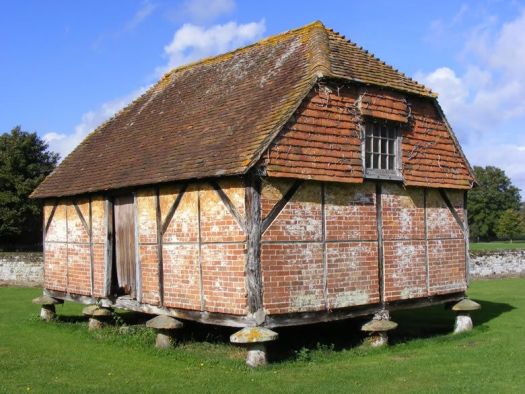Difference between revisions of "Granary"
Tao alexis (talk | contribs) |
Tao alexis (talk | contribs) |
||
| Line 1: | Line 1: | ||
[[File:Granary.jpg|right|525px|thumb|''lacking appropriate art for this page'']] | [[File:Granary.jpg|right|525px|thumb|''lacking appropriate art for this page'']] | ||
| − | '''Granaries''' are stone buildings designed to store and preserve threshed grain or animal feed. Grain must be kept from moisture for as long as possible to preserve it in good condition and prevent mold. | + | '''Granaries''' are stone buildings designed to store and preserve threshed grain or animal feed. Grain must be kept from moisture for as long as possible to preserve it in good condition and prevent mold. Granaries are erected away from inhabited buildings, as any chimney or hearth represents a source of danger to the dry grain they contain. |
== Preparing Grain == | == Preparing Grain == | ||
| Line 7: | Line 7: | ||
== Storage == | == Storage == | ||
Once in the granary, grains are stored in massive earthenware jars specially designed to maintain a cool, dark environment. Baskets and sacks do serve, but it's best to transfer grain in these to jars after the first year. If managed well, grain can be stored for seven years, which is vital given the dangers of one or more years of drought and lost crops during that time. A community's welfare depends upon the careful management of its existing grain, which is expected to last much more than a single year. | Once in the granary, grains are stored in massive earthenware jars specially designed to maintain a cool, dark environment. Baskets and sacks do serve, but it's best to transfer grain in these to jars after the first year. If managed well, grain can be stored for seven years, which is vital given the dangers of one or more years of drought and lost crops during that time. A community's welfare depends upon the careful management of its existing grain, which is expected to last much more than a single year. | ||
| + | |||
| + | To preserve grain, it has to be moved, or "poured," over and over again, to keep it dry. Thus the granary keeper is kept working by this necessity. | ||
== Construction == | == Construction == | ||
| + | Granaries have different designs based on storage volume. While smaller stores are built in [[Hamlet|hamlets]], larger stores are located in castles and monasteries (tithe barns), at ports or within cities. | ||
Revision as of 07:08, 29 December 2022
Granaries are stone buildings designed to store and preserve threshed grain or animal feed. Grain must be kept from moisture for as long as possible to preserve it in good condition and prevent mold. Granaries are erected away from inhabited buildings, as any chimney or hearth represents a source of danger to the dry grain they contain.
Preparing Grain
Newly harvested grain brought into a granary tends to contain excess moisture, so it's traditionally spread in thin layers on a dry barn floor, to aerate it thoroughly. This can take between 5 days and six weeks, depending on the climate; if not dry by six weeks, 10% of the yield must be culled from the remainder and the grain taken to a drier, underground space. If one isn't available, the whole crop may be lost. Once the grain is sufficiently dry, it can be transferred to the granary.
Storage
Once in the granary, grains are stored in massive earthenware jars specially designed to maintain a cool, dark environment. Baskets and sacks do serve, but it's best to transfer grain in these to jars after the first year. If managed well, grain can be stored for seven years, which is vital given the dangers of one or more years of drought and lost crops during that time. A community's welfare depends upon the careful management of its existing grain, which is expected to last much more than a single year.
To preserve grain, it has to be moved, or "poured," over and over again, to keep it dry. Thus the granary keeper is kept working by this necessity.
Construction
Granaries have different designs based on storage volume. While smaller stores are built in hamlets, larger stores are located in castles and monasteries (tithe barns), at ports or within cities.
